Sámi Drums – Then and Now
- Sámi Worldview
- Types of Sámi Drums
- Noaidi Uses of the Sámi Drums
- Christianity's Response to the Sámi Drum
- Sámi Drum as a Symbol
- Symbols on the Sámi Drums
- Conclusion
- Illustrations
- Bibliography
Historically, drums figure heavily in ritualistic activities. The beat of a drum attracts attention and invites some type of physical response. Many images depicting religious or spiritual behavior among indigenous peoples include drums. This holds true when examining the traditional Sámi. “The Sámi people inhabit a land they call Sápmi, stretching from the Norwegian coast in the north-west, across the northern parts of Sweden and Finland, to the Kola Peninsula in the north-east, a part of Russia.” (Jarving) The Sámi have a strong tradition of drum use in their spiritual rituals. According to The Saami Shaman Drum, a book written in 1991; “The approximately 70 drums that have been preserved constitute an extremely important source of data for the study of Saami culture and religion; however, their interpretation remains an area that still awaits research.” (Ahlbäck and Bergman 7) This paper will explore different aspects of the drum from the traditional Sámi culture. Any reference to the drum should be seen in a traditional sense unless otherwise stated. The aspects of the Sámi drums discussed include some cultural background of the Sámi, the types of drums, the shamanistic uses of the drums, the destruction and attempted removal of the Sámi drums, the symbolism of the drums, and the symbolism on the drums.
Sámi Worldview
Any discussion of Sámi culture, and the role of the Sámi drum in that culture, requires a general understanding of the Sámi worldview. “Living off of nature has formed the original conceptions of the world among Sámi; the world view was animistic by nature, with shamanistic features. They believed that all objects in the nature had a soul.” (Yli-Kahu) This animistic, and consequently polytheistic, view deeply influenced Sámi traditions. It logically leads to the desire for harmony with nature, and this leads to the need for shamans. “According to the traditional Sámi beliefs, the world was inhabited by spirits. Human beings could only successfully make their living by cooperating with natural forces. It was essential not to damage nature, as that would interfere with the higher spirits. The religious practices were cyclical, respecting the pattern of seasonal migration and the cycle of nature.” (Lehtola 88) Understanding the physical aspects of life could be achieved through instruction, example, and observation. However, understanding the spiritual aspects of life required someone capable of contacting the spiritual world. “In the old culture, human relationships with the two realms of reality, the physical world (‘this side’) and the spiritual world (‘the other side’), were bridged by the activities of the special men and women – noaidi.” (Lehtola 28) The Sámi shaman, the noaidi, became a way to tap into the spiritual side of nature.
The ability to consult the spiritual world suggests the possibility for persuasion of the spirits who rule the natural world to aid the Sámi, or at least the possibility of living in harmony with these spirits. “Important places had their divinities. Every force of nature had its god and sources of livelihood were guarded by beings in spiritual world which could be persuaded to be more favorable.” (Yli-Kahu) The noaidi turned to the drum to help them travel in and out of the spirit world. “The noaidi’s most important instrument was the noaidi drum. It was a tool to enter the ecstatic state as well as a ‘map’ the noaidi used for orientation in the other realm.” (Lehtola 29) So, the drum presented the noaidi an opening and a map into the spiritual realm. But, let’s look at the types of drums the Sámi created before elaborating on the noaidi uses of the drums.
Types of Sámi Drums
The Sámi drum, of course, consists of wood for the base and reindeer hide for the face. The ages of the drums residing in museums today are not specifically known. “The known drums are as a rule assumed to be from the seventeenth century or the eighteenth, when most of them were collected.” (Ahlbäck and Bergman 81) These drums can be divided into two distinct categories according to their physical construction. “The preserved Saami drums mainly belong to two types. The oldest is considered to be the so-called ‘frame (sieve) type’, most of which have a frame consisting of a single strip of wood bent into a circle. According to Manker (Ernst Manker studied and wrote about the Sámi drums in the mid-1900s), in the Saami area this type of drum was gradually displaced, principally southwards, but also northwards. In its place came the so-called ‘bowl type’, which thus seems to have developed from the former, and is known only from Saami culture. Already at the time of the first reliable illustrations of drums, the ‘bowl type’ was more widely dispersed than the ‘frame’ one.” (Ahlbäck and Bergman 81) In the novel The Night Between Days, Ailo Gaup describes the construction of both types of drums. He explains that the bowl drum was made from a burl off a tree. (Gaup 1988) The frame drums are typically larger than the bowl drums due to the material used for construction. This made the bowl drum easier to transport, and may be one reason the bowl drum was more widely dispersed.
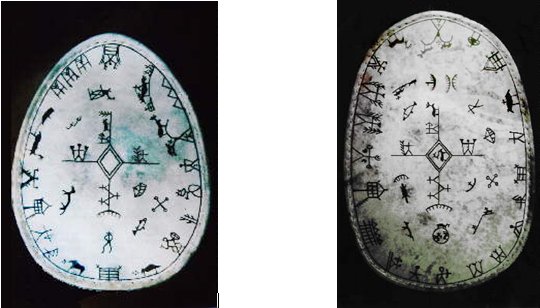 Fig 1 The left drum is a bowl drum. The right drum is a frame drum
Fig 1 The left drum is a bowl drum. The right drum is a frame drum
Because of the nature of the construction of the drums, the frame drums tended to obtain a stretched out, oval shape. The bowl drums, on the other hand, took on the shape of the burls they were made from, which typically were rounder or even egg shape. As previously stated, the back of the frame drum had cross bracing and minimal decoration adorned the cross bracing of the frame drums. On the other hand, the single burl construction of the bowl drums allowed the Noaidi the freedom of adorning the bowl part of the drum with carvings. (Ahlbäck and Bergman 81-95) The following quote references other physical components, which can be considered extensions of the drum: “Central to their shamanism is the runebom, their drum, a relatively small drum, often oval, very light and hand held, used with a drumstick carved out of a reindeer bone. The drum may be decorated with various symbols of the divine and the mundane, in a certain pattern for each shaman, and as a part of its use they put a ring of brass or silver on the skin, drum, and do divination from how the ring moves over the skin. But the primary use of the drum is for the shaman to go into trance and travel in the spirit world.” (Jarving) Apparently, the development of the Sámi drum relied heavily on their close relationship with the reindeer. The reindeer’s hide provided the drumming surface, the reindeer’s sinews provided the means to attach the hides to the body of the drum, and the bones provided hammers and pointers.
Two distinct types of decoration appear on both the frame drums and the bowl drums. The two types are the heliocentric drum face and the segmented drum face. They are described in the book, The Saami Shaman Drum, this way: “The Saami drums can be divided into those in which the symbol of Paivo, the sun, with its reins (labikies), is situated in the middle of the drum heads, and those whose illustrated surfaces are separated into two or more sections.” (Ahlbäck and Bergman 64) The magic drum, therefore, was either a frame drum or a bowl drum with either a heliocentric pattern of symbols or a segmented pattern of symbols on the drum face.
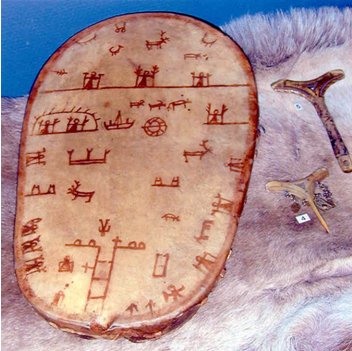
Fig 2 Pictured is a segmented frame drum with a hammer and a pointer.
Noaidi Uses of the Sámi Drums
As with any instrument, the use of the drums probably varied from individual to individual. “There is no doubt, however, that the drum has been an important part of Saami shamanism. Its foremost role, of course was to serve as an instrument of ecstatic excitation. Secondarily, it functioned as an instrument of divination.” (Ahlbäck and Bergman 12) By hammering the drum, the noaidi beat out a rhythm that inspired ecstatic excitation, this then allowed the shaman to achieve a trance state. “In a non-active state – in a dream, trance or coma – a free soul may leave the body and take on another form outside of the person. The noaidi had the skill to reach this state at will. It is described in different ways. The noaidi in a trance leaves the body and moves as a spirit or breath of wind. They have the ability to change into a wild reindeer or hide under the reindeer’s neck or hoof; they can fly over the treetops or travel under the ground; they may swim in the shape of a fish; and the Sea Sámi recount they may even move mountains.” (Lehtola 28) This type a shamanistic travel dates back even before any of the existing drums. “In the well-known report of an ecstatic Saami shamanistic séance in Historia Norvegiae, written down in c. A.D. 1170/90, there is a description of a drum, like a sieve and with some simple figures painted on the drum skin: a whale, a reindeer, a ski and a small boat with oars. With the help of these, the ‘gandr’ of the shaman, his free soul, could travel over fell and fjord.”(Ahlbäck and Bergman 85) This obviously describes a Sámi shaman using a frame drum to achieve a trance and free his spirit to travel along the surface of this world.
The Sámi also believed in other worlds that the noaidi could travel through. “The Sámi believed that alongside with [sic] the material world there was an underworld, saivo, or (Jábmiid) áibmu, where everything was more whole than in the material world and where the dead continued their lives.” (Yli-Kahu) The segmented, patterned drums divide the drum’s surface. These divisions could represent the different levels of the different worlds.
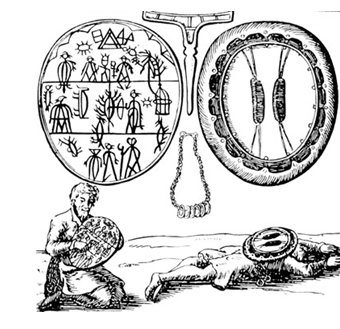
Fig 3 This drawing depicts a Sámi shaman in ecstasy.
The drum pictured in Figure 3 has a segmented pattern that shows three levels. The upper level possibly represents the level of the Gods. The middle level then would represent the level of men. The bottom level would represent saivo-the paradise underworld of the Sámi ancestors. The following description explains how a noaidi could use his ability to travel to spiritual levels to heal people and control nature:
Shamanistic activities were related to crisis situations in a village or family; the noaidi attempted to find a remedy. The greatest crises, for this people dependent on nature, were illnesses and problems concerning obtaining a livelihood. Illness is a disturbance of the balance between the two souls and between the two realms of reality. The noaidi, in spirit form, leaves and goes to ‘the other side’ to restore harmony. Innumerable tales relating to obtaining a livelihood and epic poems tell that a “trance noaidi” was able to control the movements of a whole reindeer herd. (Lehtola 28-29)
The next account includes divination as an aspect of noaidi shamanism using a drum:
Some people were capable to [sic] foretell future events, or fortune in hunting etc. A person with this special gift could be ‘called’ and accepted by the community as a noaidi (shaman). A noaidi was capable of visiting the saivo and people from far away would come to him/her for advice. For more demanding “trips” a noaidi sometimes used a “magic drum”, much in the similar way as the northern Siberian shamans. (Yli-Kahu)
Finally, a recent Sámi interpretation of Sámi shamanism comes from Ailo Gaup, a modern Sámi author. In his novel, The Night Between Days, written in 1992, he writes:
In the old days the noaides were asked for advice in many matters. They were healers. They traveled with their soul bodies over the tundra, were on the lookout for game when hunger threatened. They sang fish into the net and whales up on the beach. They controlled weather and moved islands. They led enemies astray. They kindled love. They sent the spirits of illness home and brought souls back. They entertained on long nights; they told stories, sang and clowned. They competed to find treasure of silver and gold. They worked with forefathers and guardian spirits and with nature’s forces. (Gaup 1992:104)
Christianity's Response to the Sámi Drum
The Reformation of the 16th century spread Lutheranism outward from Germany and, of course, reached the Scandinavian countries. Soon the religious fervor of Christianity overcame the Sámi. With their pagan rituals the Sámi became included in the church’s witch hunts. “In Arctic Norway over 175 people were prosecuted for the crime of witchcraft from 1593 to 1695. The witch trials of the far north are distinctive in a European context because of the elements of Sámi magic. About 20% of the witch trials are known to have affected the Sámi.” (Hagen) The Sámi were accepting of the Christian faith. They simply incorporated Christianity into their other beliefs. However, the church required the rejection of anything other than Christianity, and persecuted the Sámi. “The image of noaidi-ism changed because of Christian belief. During the era of the witch hunts the word noaidi clearly took on a negative meaning. All people who practiced the old religion were held to be people who had given themselves to immortality or the Devil – they were believed to have sold their own souls, their relatives’ and even their children’s souls. This belief persisted even into the 1900s.” (Lehtola 29) Many Sámi relented and publicly embraced Christians.
Christianity harshly persecuted those who held to the Sámi religion. “From the end of the 17th to the middle of the 18th century much of the confrontation between indigenous Saami religion and Christianity was focused on the drums.” (Ahlbäck and Bergman 29) The church burned most of the confiscated drums; therefore, few drums remain today. “As a powerful and very visible part of the Sámi religion, the drum was one of the main focuses of the Christian attempts to eradicate their religion, so most of the older Sámi drums have been crushed or burnt by Christian missionaries and their armed escorts.” (Jarving) The Sámi gave up many of the drums to avoid persecution. Persecution took on many forms, from being questioned and forced to deny the Sámi religion, to being put to death as a heretic.
During the witch trials in Finnmark, two Sámi drums were confiscated. One of the owners had to answer questions about the use of the drum, and about the meaning of all the figures and symbols on his drum. Trying to find traces of shamanism, the article emphasizes on the trial records of this particular case. These records date from one of the last but most momentous witch-trials in 1692. An old Sámi shaman, Anders Poulsen, told the court about the symbols and the use of his magic drum. He also stood up and demonstrated the instrument for the people being present in the courthouse of a small fishing village called Vadsø. The assessment of the court case upholds the findings which criticize ecstasy and trance as choice characteristics when trying to determine what exactly the shaman world view consists of.” (Hagen)
Shamanism was seen as a type of devil worship. Shaman drumming, and ritual practices put them in league with the devil. Consequently, Christianity characterized Sámi noaidi as witches who consulted demons, and persecuted them mercilessly.

Fig 4 This drawing depicts demons being consulted by the noaidi.
One last account of Sámi persecution deserves mentioning.
In 1688 the county governor and the bishop (Swe. superintendent) made a journey of inspection through the lappmarks. The Saamis were summoned and threatened with ‘temporal and eternal punishment’ if they did not hand over their drums and ‘idols.’
One of the Saamis who handed over a drum in this year was the Pite Saami, Lars Nilsson. When he later lost his son, he used a drum in a futile effort at bringing him back to life. He was prosecuted, but at the district court sessions he explained outright that he would “observe and use the custom of his forefathers, in spite of what higher or lower authority in this case would now or in the future prohibit him from doing”. He was sentenced to death, the judgment was ratified by the court of appeal, and he was thus decapitated and burnt at the stake “together with the tree-idols he had used and the divination drum and the tools belonging to it.” The execution was held in the presence of his kinsman, who had been summoned to attend. (Ahlbäck and Bergman 32)
With these consequences, there is little wonder why many Sámi let go of their traditional beliefs and drums. Fortunately, some Sámi went underground with their religion, and some of their worldview survives today along with the tradition of the Sámi drum.
The Sámi Drum as Symbol
The uniqueness of the traditional Sámi drum represents a distinct Sámi-ness, and makes a superb symbol of the Sámi culture. “The role of the drums as symbols of Saami resistance is well attested in the sources from the 17th and 18th centuries. For the Saami, the drums represented their threatened culture, the resistance against the Christian claim to exclusiveness, and a striving to preserve traditional values – i.e. ‘the good’ that had to be saved. For the Church authorities, on the other hand, the drums symbolized the explicit nucleus of the elusive Saami ‘paganism’ – i.e. ‘the evil’ that had to be annihilated.” (Ahlbäck and Bergman 29) The Sámi author, Ailo Gaup emphasized the importance of the drum as a Sámi symbol by writing two novels about the drum, In Search of the Drum (1988) and The Night Between Days (1992). The symbols on the drums even influence the official design of the Sámi flag. “The Sámi have their own [sic] flag which was officially acknowledged in the 13th Nordic Sámi Conference in 1986. The flag is [sic] designed by Astrid Behl from Ivgubahta/Skibotn in Norway. The basic idea in the flag is a symbol from a drum. The circle is a symbol of sun and moon–the sun ring is red and the moon ring blue. The colors are also the colors used in Sámi costumes.” (Yli-Kahu) In a way, the drum still bridges gaps between worlds, the old traditional Sámi world and the modern world that the Sámi embody today. The drum still functions as a way to view the world in a holistic manner.
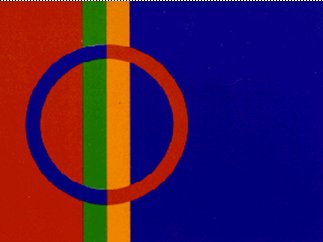
Fig 5 Pictured is the Sámi Flag, with the sun/moon symbol.
The Symbols on the Sámi Drum
With the virtual eradication of the traditional Sámi noaidi, it becomes difficult to know the meanings of the symbols on the Sámi drums. “Under the stern Christianization, the great noaidi – those who had the power of ecstasy – appear to have disappeared by the 1800s.” (Lehtola 29) I will not try to interpret Sámi symbols drawn on 300-year-old drums. Nonetheless, some symbols show important aspects of Sámi life, and reflect the Sámi desire to live in harmony with nature, even to the untrained eye. The frequency and placement of the sun symbol reflects the central nature of the sun in Sámi tradition, and suggests that the sun’s importance cannot be overstated. Many symbols obviously represent animals familiar to the Sámi. “The animal that seems most appropriate to begin with is the reindeer, which is the commonest species of animal on the southern Saami drums.” (Ahlbäck and Bergman) Other animals also seem obvious, such as, bears, wolves, and birds.
The inclusion of non-Sámi symbols, including Christian symbols, on some of the drums becomes one of the most curious features about the drums. “This adoption of Christian and Swedish symbols can also be seen as a result of the confrontation between Saamis and the overwhelming Norwegian, Swedish and Finnish cultures. The Saamis may have wished to magically incorporate their opponents’ symbols of power into their own culture in order to gain access to these same sources of power.” (Ahlbäck and Bergman 86) Some believe the Sámi included Christian symbols because it was safer to do so. Others believe that the drums illustrate a wonderful ability to mix pagan and Christian, to mask one’s religion during inquiry. (Ahlbäck and Bergman 37) Still, another interpretation would be that the Sámi simply included the Christian symbols because they accepted Christianity as valid along with their own traditions.
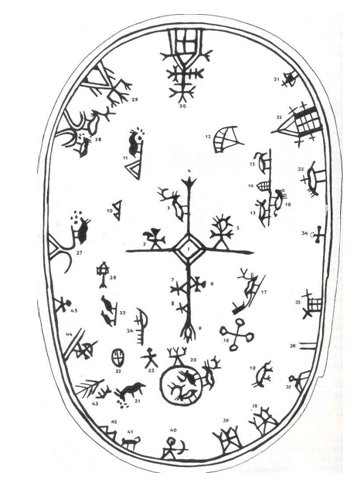
Fig 6 Many animal and Christian symbols can be seen on this heliocentric drum.
The incorporation of Christianity into the Sámi worldview seems to have made its way into the first novel written by Ailo Gaup about the Sámi drum. While the main character (Jon) is on a spiritual trip, consulting his spiritual helper (Jov), he also encounters Jesus. Gaup reconciles the Sámi and Christian beliefs this way; “Deep inside his heart he saw a landscape. On a mountain a man was sitting by a stone. He had a halo around his head. It was Jesus who sat there. Then Jov came walking. Jov and Jesus were good friends, had much to talk about. They were often together in the mountains where they gained strength to help people. Jov had the drum with him. They were sitting there talking about it.” (Gaup 1988:121) Gaup depicts Jesus as another way to obtain spiritual aid. He further includes other religions in his second novel. The fact that the Sámi have historically been quite adaptive adds credence to this interpretation.
A different hypothesis about the symbols on the Sámi drums emerged in the 1980s. The man who introduced the star map hypothesis, Bo Sommarström, examined the position of the symbols on drums with a central cross design, including 41 drums from the “Southern Sámi” group. Sommarström concluded that; “it seems safe to assume that both the Zodiac circle and separate constellations have beyond doubt influenced the positioning of several of the figures on the Southern type of Sámi drums.” (Ahlbäck and Bergman 143-144) Sommarström found that 3 of the figures he interpreted as Zodiac constellations (the Ram, the Virgin, and the Archer), and 3 of the symbols he interpreted as separate constellations (the Milky Way, Pegasus, and Orion) occurred frequently. Even with this supportive information, Sommarström points out; “It is important to bear in mind that the star map hypothesis does not replace other interpretations: in principle it only affects the system of arranging the figures on the drum skin.” (Ahlbäck and Bergman 145) Sommarström and others conducted extensive tests concerning the star map hypothesis. With all the information gathered, Sommarström concluded; “In the course of this new study, I have become even more convinced that the star map hypothesis is a model that can be used to explain the basic pattern of the figures on the Saami drums of the Southern type.” (Ahlbäck and Bergman 161) The star map hypothesis appears feasible, and at least should be considered as a possibility for the placement of Sámi symbols on the drums.
Conclusion
The Sámi drum contains many mysteries. In this paper I have touched on the aspect of the drum for noaidi use. However, in class we learned that one didn’t have to be a shaman to own or use a drum. We also learned that every Sámi household probably owned a drum before the persecution brought about by Christianity. Drums, no doubt, were used to accompany yoiking, and a shaman wouldn’t necessarily need a drum to enter the spirit world. Even so, the mystical aspect of the Sámi drums offers a romantic and inviting symbol of the Sámi. The figures on the drums are distinctly Sámi, and the drums themselves present an excellent symbol for the Sámi people. It is a symbol that can be heard as well as seen. Sámi culture adapts to modern influences, and the Sámi people incorporate modern conveniences into their lifestyles. But the old traditions haven’t passed away yet. The 73 remaining Sámi drums represent a moment in Sámi culture preserved in wood and skin. Therefore, we should once again see the drums as a way to bridge, a way to connect the old and the new. They remind us to reflect on the plight of the Sámi people, and to ponder the price of progress. By being reminded of these things, perhaps we can even look at the drums as a symbol of hope for the future of the Sámi people.
Illustrations
Fig. 1. Boreale, “Sámi Handicraft.” 10 March 1997 <http://www.itv.se/boreale/duodjie2.htm>
Fig. 2. Photo provided by Joavnna Weinstock
Fig. 3. Jarving, Stein. “Sámi Shamanism.” Eutopia Adventure.16 June 2004 <http://www.eutopia.no/Sámisjaman.htm>
Fig. 4. Hagen, Rune Blix. “The Shaman of ALTA.” The University of Tromsø 2 May 2004 <http://www.ub.uit.no/fag/historie/shaman.html>
Fig. 5. Yli-Kuha, Kari. “Sámi Mythology.” The Sámi. 12 June 1998 <http://www.lysator.liu.se/nordic/scn/faq23.html>
Fig. 6. Ahlbäck, Tore and Bergman, Jan. eds. The Saami Shaman Drum . Abo, Finland: The Donner Institute for Research in Religious and Cultural History, 1991.
Bibliography
Ahlbäck, Tore and Bergman, Jan. eds. The Saami Shaman Drum . Abo, Finland: The Donner Institute for Research in Religious and Cultural History, 1991.
Boreale, “Sámi Handicraft.” 10 March 1997 <http://www.itv.se/boreale/duodjie2.htm>
Gaup, Ailo. and Sjordal, Bente Kjos, trans. In Search of the Drum. Fort Yates, ND: Muse Publications. 1988:1992
Gaup, Ailo, and Weinstock, Joavnna. trans. The Night Between Days. 1992:2003
Hagen, Rune Blix. “The Shaman of ALTA.” The University of Tromsø. 2 May 2004 <http://www.ub.uit.no/fag/historie/shaman.html>
Jarving, Stein. “Sámi Shamanism.” Eutopia Adventure.16 June 2004 <http://www.eutopia.no/Sámisjaman.htm>
Lehtola, Veli Pekka. The Sámi People, Traditions in Transition. Aanaar-Inari: Kustannus-Punsti, 2002
Yli-Kuha, Kari. “Sámi Mythology.” The Sámi. 12 June 1998 <http://www.lysator.liu.se/nordic/scn/faq23.html>
